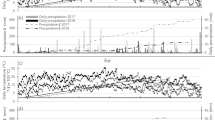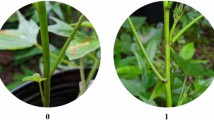Abstract
Simultaneous planting and final ridge formation using a deeper planting depth is necessary in order to achieve good soil cover of tubers and fewer green tubers. Three planting depths were used: planting depth 1 (the shallowest), planting depth 2 (the medium), and planting depth 3 (the deepest). Planting depth 3 led to the largest minimum distance of tubers from the ridge side, and the smallest percentage of tubers in the upper layer of the ridge (0 to 5 cm). However, the highest yield and percentage of green tubers and the smallest marketable yield occurred at the shallowest planting depth (1). The tuber cluster covers 80 to 90% of the area of the ellipse. Empty spaces surrounding the tuber cluster in the ridge also affect the percentage of green tubers in the ridge, which predominantly occur at planting depth 3 and are the rarest at planting depth 1.
Resumen
En la siembra simultánea y la formación de las crestas finales se necesita una mayor profundidad de la siembra para lograr cubrir bien los tubérculos y los tubérculos menos verdes con la tierra. Se utilizaron tres profundidades de plantación: la profundidad de plantación 1 (la más superficial), la profundidad de plantación 2 (el medio), la profundidad de plantación 3 (la más profunda). La distancia mínima más grande de los tubérculos desde el borde de la cresta y el porcentaje más bajo de tubérculos en la capa superior de la cresta(de 0 a 5 cm) se ha alcanzado en la profundidad de plantación 3. Por otra parte en la profundidad de plantación 1 se produjo el máximo rendimiento y el porcentaje de tubérculos verdes, así como el menor rendimiento comercial. El cúmulo que rodea los tubérculos cubre el de 80 a 90% del área de la elipse. Los espacios vacíos alrededor del cúmulo que rodea los tubérculos en la cresta también afectan el porcentaje de los tubérculos verdes y predominan en la profundidad de siembra 3, siendo los más raros en la profundidad de siembra 1.












Similar content being viewed by others
References
Arora, R.K. 1989. Distribution of healthy and late blight infected tubers in potato ridges. Indian Journal of Mycology and Plant Pathology 19: 232–233.
Bailey, P.H. 1957. An investigation into the distribution of potatoes in the ridge. Journal of Agricultural Engineering Research 2: 146–151.
Bohl, W.H., and S.L. Love. 2005. Effect of planting depth and hilling practices on total, U.S. no. 1, and field greening tuber yields. American Journal of Potato Research 82: 441–450.
Burkhalter, R. 2011. Wie erzielt man den perfekten Damm? Kartoffelbau 62: 28–32.
Heiss, A. 2009. All in One. http://www.agrarnet.info/netautor/napro4/wrapper/media.php?id. Accessed 23 Aug 2009.
Kouwenhoven, J.K. 1967. Recent development in potato ridging in the Netherlands. European Potato Journal 3: 257–271.
Kouwenhoven, J.K. 1970. Yield, grading and distribution of potatoes in ridges in relation to planting depth and ridge size. Potato Research 13: 59–77.
Kouwenhoven, J.K. 1978. Ridge quality and potato growth. Netherland Journal of Agricultural Science 26: 288–303.
Kouwenhoven, J.K., and U.D. Perdok. 2000. Ridges for new potato varieties in The Netherlands, 1–10. Soil Technology Group: Wageningen University.
Kouwenhoven, J.K., U.D. Perdok, P.K. Jonkheer, P.K. Sikkema, and A. Wieringa. 2003. Soil ridge geometry for green control in French fry potato production on loamy clay soils in The Netherlands. Soil & Tillage Research 74: 125–141.
Lacey, D. 1966. The distribution of healthy and blighted tubers in potato ridges. European Potato Journal 9: 87–96.
Lewis, W.C., and R.G. Rowberry. 1973. Some effects of planting depth and time and height of hilling on Kennebec and Sebago potatoes. European Potato Journal 50: 301–310.
Pavek, M.J., and R.E. Thornton. 2009. Planting depth influences potato plant morphology and economic value. American Journal of Potato Research 86: 56–67.
Peters, R. 2009. Kombination von Arbeits-gängen beim Kartoffellegen. Kartoffelbau 60: 4–9.
Stalham, M.A., J.H. Fowler, and M.J. Pavek 2001. Effect of planting depth and re-ridging on crop growth and tuber greening in FL 1953. In: Cambridge University potato growers research association annual report 2001. Cambridge, CUPGRA: 16–21.
Vučajnk, F., M. Vidrih, and R. Bernik. 2012. Physical and mechanical properties of soil for ridge formation, ridge geometry and yield in new planting and ridge formation methods of potato production. Irish Journal of Agricultural and Food Research 51: 13–31.
Wulf, B., J. Grocholl, and B. Seidel. 2001. Zeitpunkt des Dammaufbaus. Kartoffelbau 52: 80–83.
Wurr, D.C.E., C.C. Hole, J.R. Fellows, J. Milling, J.R. Lynn, and P.J. O'Brien. 1997. The effects of some environmental factors on potato tuber numbers. Potato Research 40: 297–306.
Author information
Authors and Affiliations
Corresponding author
Rights and permissions
About this article
Cite this article
Vučajnk, F., Bernik, R. & Vidrih, M. Tuber Position in the Ridge in Relation to the Planting Depth with the Technology of Simultaneous Planting and Final Ridge Formation. Am. J. Potato Res. 94, 500–512 (2017). https://doi.org/10.1007/s12230-017-9587-z
Published:
Issue Date:
DOI: https://doi.org/10.1007/s12230-017-9587-z




